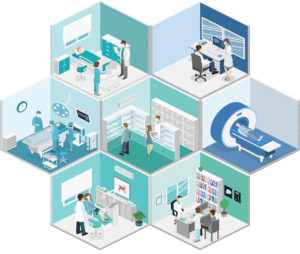An Introduction to Ontario Health and Ontario Health Teams
There is no question that Ontarians have access to an incredible health care system provided by some of the best health care workers in the world; but that doesn’t mean that there isn’t room for change and improvement. Long wait times, busy ERs, and patients having to worry about navigating the current system on their own without a proper support network, are all issues that need to be addressed.
Patients and families find it difficult to navigate the current system. It may be a matter of not being able to find timely health care, due to long wait-times or inconvenient service hours. For others, it can be difficult to know where to go for the right kind of care. By not knowing how to access community services or waiting too long for a service because there are not enough available, many people reach a crisis point that leads them to the emergency department.
Either way, too many patients are ending up in the ER, waiting hours for care that may have been more appropriately provided in a different care setting, or avoided entirely, by proactive and preventative measures. These challenges with navigation and timely access also contribute to the problem of hallway health care. Hallway health care is a term used when patients are waiting for a hospital bed in an unconventional location.
Visiting the emergency room for health care that could be provided somewhere else happens frequently in Ontario, sometimes because it’s the only health care setting that is open 24/7. According to the 2018 Health Care Experience Survey, 41% of Ontarians who went to the emergency department and 93% who went to a walk-in clinic received care for a condition that could have been treated by their primary care provider.[1]
Focus on preventative care initiatives and engagement with primary care providers could help reduce the number of people seeking care in emergency departments and hospitals. The current government is working towards making changes to help build a public health care system that will aim to improve people’s access to the care that they need, where they need it. Integrated care is key to improving patient care, experience, and outcomes. The goal is to create better, faster, more connected care for patients, regardless of where they are in their health care journey.
By consolidating the current model of multiple health care agencies and organizations into a single agency, Ontario Health, the province can oversee health care delivery and provide support to enable better quality care for patients. This is an agency with a formal Board of Directors that will facilitate all the planning at a provincial level. Organizations that would be transitioned into this new model include: Cancer Care Ontario, Health Quality Ontario, eHealth Ontario, Trillium Gift of Life Network, Health Shared Services Ontario, and Local Health Integration Networks (LHINs).
From here, local health care providers will be empowered to work as a connected team called Ontario Health Teams (OHTs). OHTs are groups of health care providers and organizations that are clinically and fiscally accountable for delivering a full and coordinated continuum of care to a defined geographic population. The OHTs will implement the plans from Ontario Health. The OHTs will provide a new way of organizing and delivering services to their defined population area. Under the OHT’s, the health care providers, including hospitals, doctors, and home care providers, will work as a coordinated team no matter where they provide care.
This means that patients and families will have access to better and more connected services and will wait less for these services. Providers will work together to provide integrated care; integrated care looks at the whole person, not just the illness. Patients and caregivers will have access to help in order to navigate the system, to answer questions and to understand their circumstances.
OHTs are a brand-new way of organizing and delivering services for patients; responsible for delivering all the care, understanding their health care and history needs and directly connecting them to the different types of care they need. As this model is phased in, OHT’s will coordinate and deliver services such as: primary care, hospital care, rehabilitative care, home and community care, residential long-term care, and mental health and addictions care.
In addition to the clinical care services mentioned, the OHT changes will also incorporate the often overlooked social determinants of health. These can include adequate housing, access to transportation, poverty and low-income demographic concerns, and assistance for marginalized groups who may require social supports in addition to the typical clinical care providers.
Patients will have help in navigating the public health care system 24/7. Teams would support continuous access to care and the transition as patients move between one provider to another, even to receive care in different locations or health care settings.
Under the OHT model, patients will continue to be able to choose who provides their health care and have better access to choices available through technology. This could include secure access to digital health services, access to electronic health records, and virtual care options. By expanding digital care options, care providers will be able to quickly access information such as specialist advice and clinical support.
OHTs will be established in phases across the province. At this time, there are thirty-one OHTs that have been granted approval to bring forward a full business plan; after which, site visits and further approvals will take place. There are forty-five more OHTs to be added in at the next phase.
As the province works to build a health care system centred around patients, Ontarians will continue to contact their current health care providers
FAQ’s of the new OHT Health Model
How will OHTs improve patient care?
Integrated care is a key component to improving patient care. The goal is to create better, faster, more connected care for patients, regardless of where they are in their health care journey.
Example: A patient needs home care when they leave the hospital. With an OHT, this patient will know before they leave who their home care provider will be, what they will be doing, and when they will arrive. If complications arise for the patient after they leave the hospital, they can be treated by the most appropriate provider within their OHT rather than having to return to the emergency department.
What is changing?
The goal is to improve the health care experience so Ontarians will have one integrated team of health care providers working together to meet your needs, a medical record that both the patient and the provider can access easily and help to navigate the public health care system 24/7.
What is staying the same?
During this transition to the new system, Ontarians can continue to access the care they need from the providers they trust. Health care services patients receive will remain uninterrupted. Patients will still go to the same doctor and will have the ability to choose their own provider. Ontarians should remain confident that what is paid for by OHIP today will be paid by for OHIP going forward.
What services will the OHTs offer?
At maturity, under the OHT model, the following services will be coordinated and delivered to meet individual health care needs:
- Primary care
- Hospital care
- Rehabilitative care
- Home and community care
- Residential long-term care
- Mental Health and Addictions Services and care
How will the OHT coordinate care need from different providers or settings?
Providers will have the ability to safely access a patient’s health care record and share it with other members on the team to ensure seamless health care even as a patient is discharged from one provider to the next. The OHT will:
- know the patient’s health history
- be aware of health care services in that patient’s area
- help the patient navigate the system 24/7
- ensure referrals get to the right place
- receive and share health records with the patient, including test results
- provide digital options such as online access to health records and virtual care.
For answers to other questions, visit: https://www.ontario.ca/page/improving-health-care-ontario as usual to receive the services they need. Until the new model reaches maturity, contact for health care services remains the same.
Patients who are supported by providers who may become part of the OHT would not need to sign up or go through any administration process. They would simply experience greater access to care and support from a broader network of other physicians and inter-professional providers, working together as a team.
Contact information for health care services remains the same:
- If you have a health concern or for your everyday health care needs, continue to contact and visit your doctor, nurse practitioner, community health centre, family health team, or Aboriginal health access centre as the first step.
- For medical emergencies, call 911 or go to the emergency
department. - To get fast, free medial advice, 24/7, call Telehealth Ontario toll free at 1-866-797-0000 or toll-free TTY at 1-866-797-0007.
- For home and community care, contact your care coordinator for any questions about your care. For information about the services in your local community and referrals, call 310-2222 (English) or 310-2272 (French)—no area code is required.
- To access community mental health and addictions services, call Connex Ontario at 1-866-531-2600 or Kids Help Phone at
1-800-668-6868.
Resources for this article:
[1] Ministry of Health and Long-Term Care. (2018). Health Care Experience Survey (HCES), April 2017 – March 2018.
http://www.health.gov.on.ca/en/public/publications/premiers_council/report.aspx | https://news.ontario.ca/mohltc/en | https://www.ontario.ca/page/ontario-health-agency
http://www.health.gov.on.ca/en/news/connectedcare/ | http://health.gov.on.ca/en/pro/programs/connectedcare/oht/







